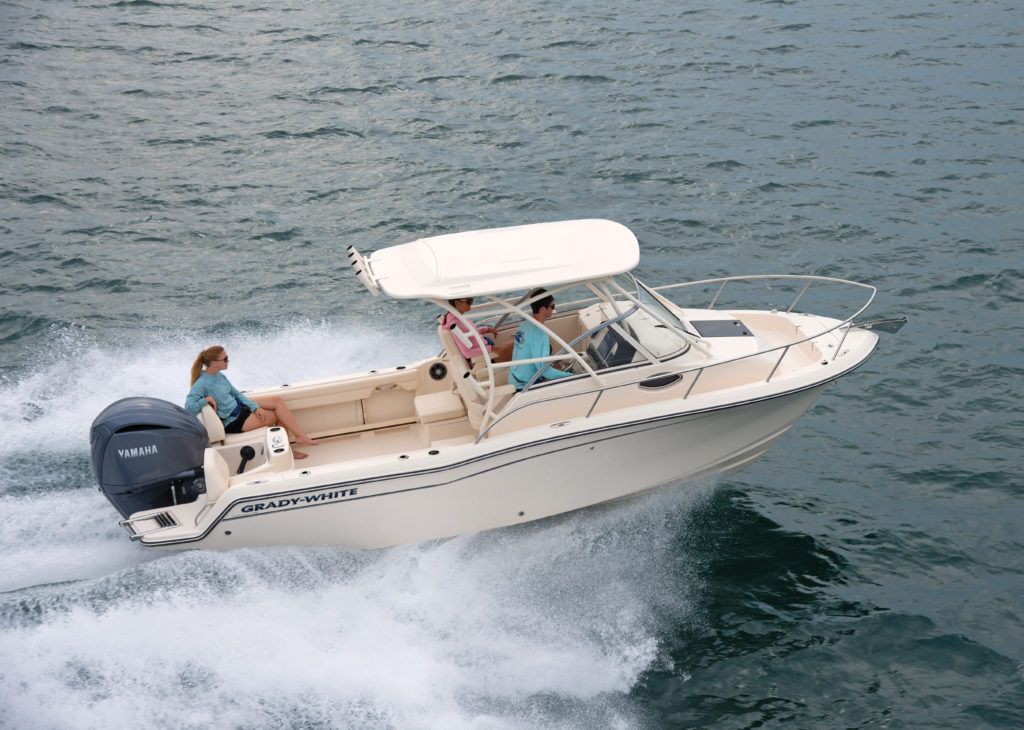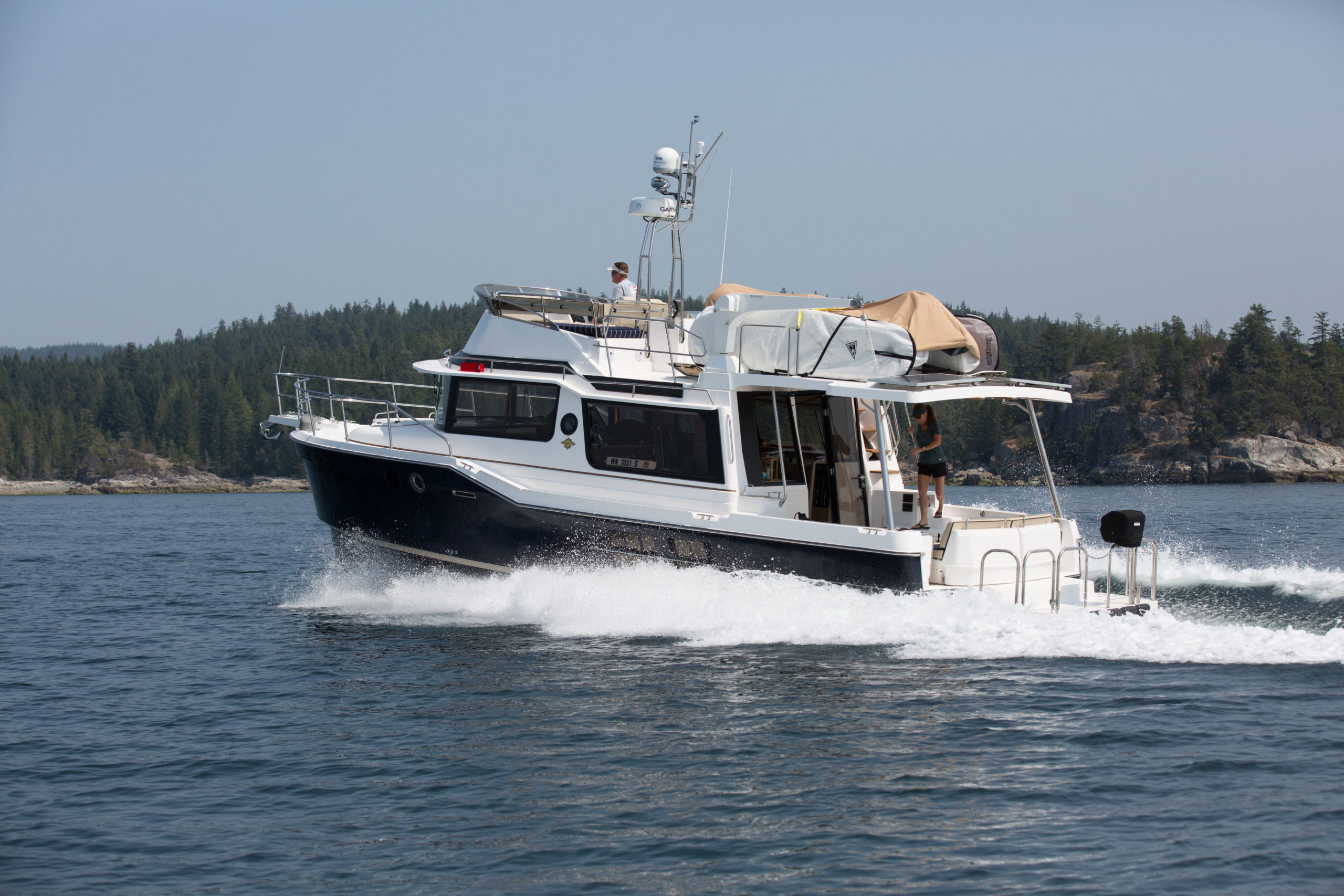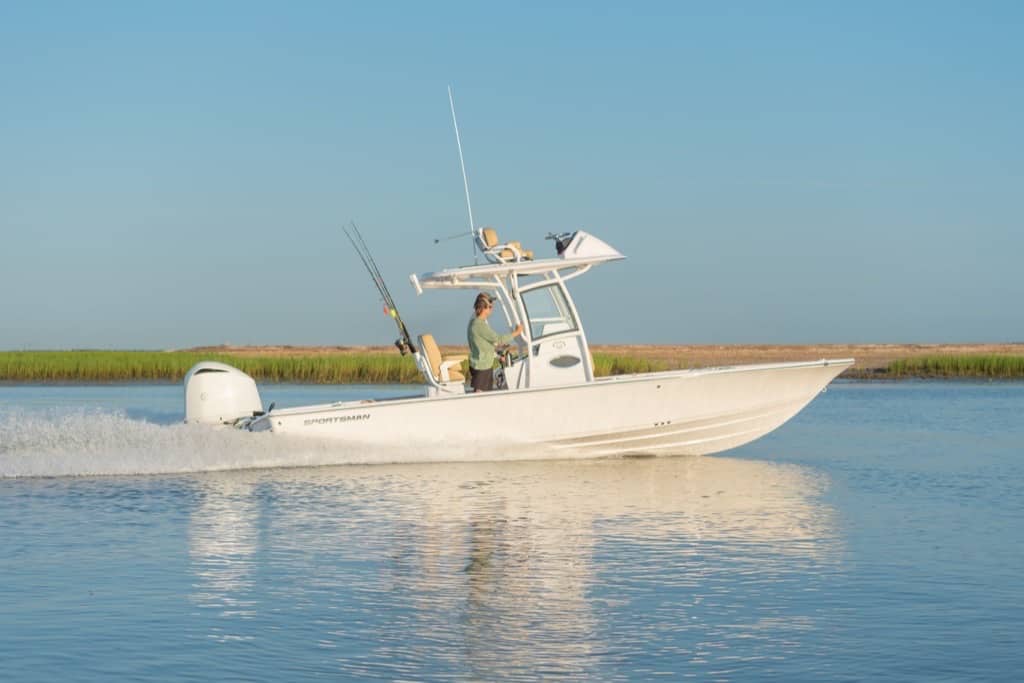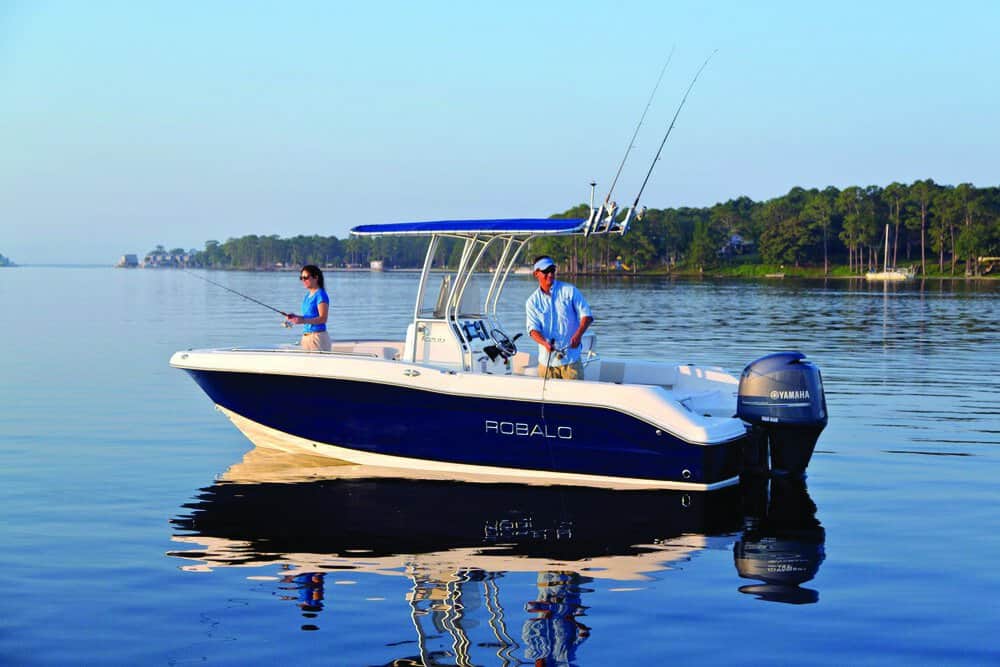In 1974, Grady-White Boats created the 204-C Hatteras Overnighter, with a lapstrake fiberglass hull. It was one of the first boats on the market with a compact “walkaround” cuddy cabin that offered weather protection around the helm. Thus it appealed to both hardcore anglers and families. Grady-White’s design team had not created the configuration, but they developed innovative, valuable details that made the 204-C the company’s bestseller through the ’70s, ’80s, and early ’90s.
Since the company’s founding, Grady-White’s planning team has always sought feedback on what works well on their boats, what doesn’t, and what additional features people want in them. They spend a great deal of time listening actively to customers, dealers, dealership service staff and their own employees, many of whom (including designers and engineers) are active boat owners themselves. As outboard engines got larger in the new century and customers began to look more for “day boats,” the market shifted toward larger dual-console and center-console boats. But the basic values of the walkaround cabin configuration remain, and enough people asked for it to trigger a new design.
Grady-White Adventure 218
LOA: 21'3" (23'3" w/ swim platforms) Beam: 8'6" Draft: 16" Cockpit Depth: 25" Weight: 3,125 lb (estimated, w/o engine) Transom Deadrise: 19 degrees (SeaV2 progression) Bridge Clearance: 5'5" (7'7" w/ hardtop) Fuel Cap: 100 gal Water Cap: 10 gal (optional) Max HP: 250
For more information visit gradywhite.com or Tri-State Marine in Deale, Md., Southeastern Marine in Richmond, Va or Norfolk Marine in Norfolk, Va.
The Adventure 218 is the first completely redesigned small walkaround cabin model since 2009. It rides on a 21’3″ x 8’6″ version of Grady-White’s trademarked SeaV2 continuously variable vee-hull, which it shares with the dual-console Freedom 215 and center-console Fisherman 216, both introduced in 2018. (Previous 20–22′ hulls had 8′ beams.) The SeaV2 shape, developed by Grady-White engineers in partnership with C. Raymond Hunt Associates, has earned a well-deserved reputation for seaworthiness with a soft ride in rough seas.
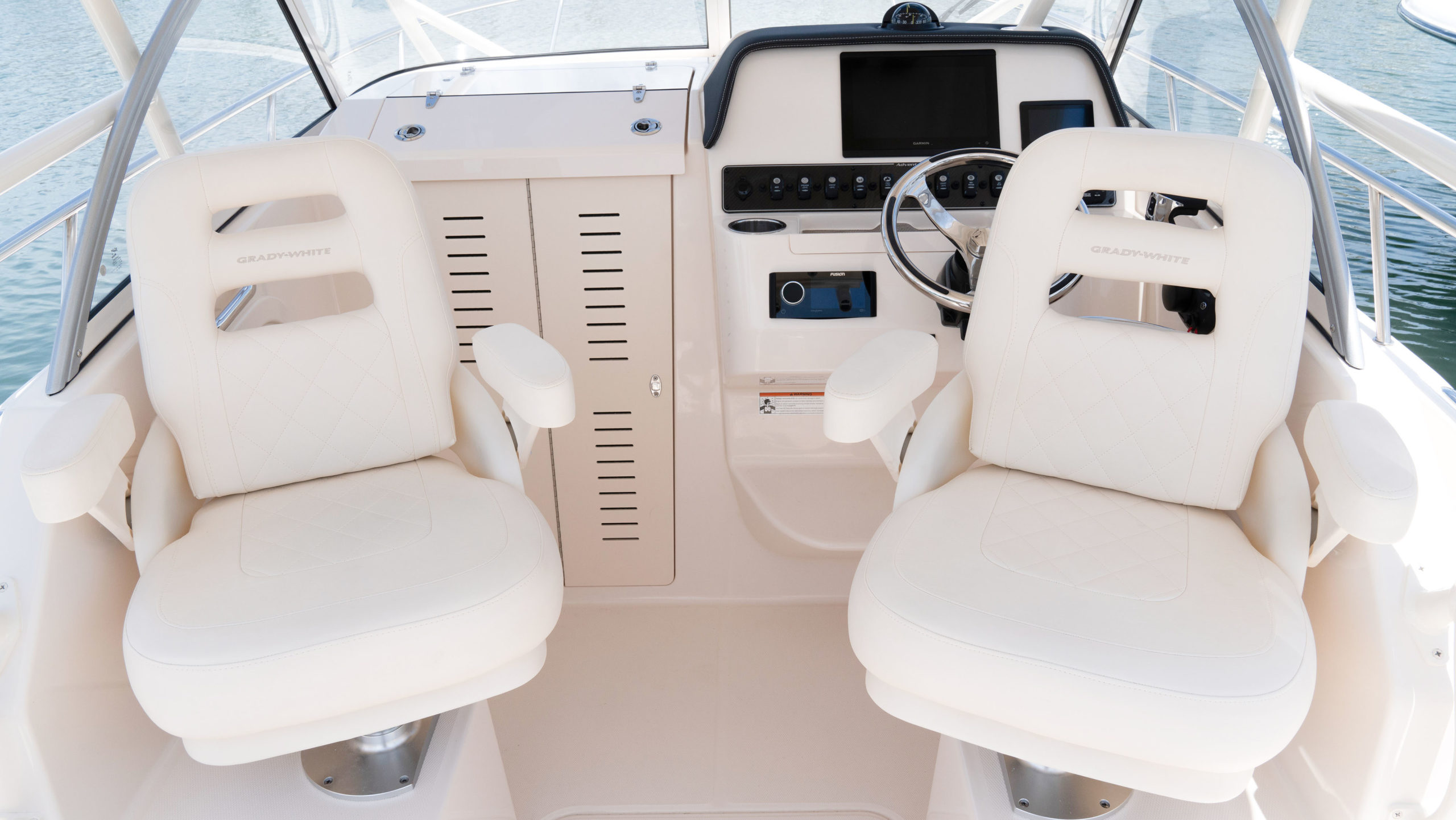

The Adventure 218 shows updated styling with a curved windshield, more bow flare, a more aggressive sheer break, a Euro-shaped transom with twin boarding platforms (telescoping ladder on starboard platform), and retractable ski pylon. It still offers a forward V-berth and a head, along with an optional modern fiberglass hardtop supported by a sturdy, painted aluminum frame. Horizontal rod holders under the gunwales secure two fishing rods up to 7′ on each side, along with a horizontal overhead rack for two in the lockable cabin. Vertical holders mount on the hardtop (two each aft side rail, four on the trailing edge), with two more in each gunwale. On deck are helm and companion seats with cushioned, aft-facing “mezzanine” seats immediately behind, over a pair of insulated cooler/fishboxes. (The port box can be plumbed for a livewell.) A complete set of weather curtains is optional, making the 218 at least a three-season boat on the Chesapeake. The package adds family features without compromising fishability.
“We have great design meetings,” said Christian Carraway, an 11-year veteran product design engineer. As a result of conversations with owners, he finds himself often developing design tweaks. Grady-White cheerfully incorporates new and redesigned features on each model each year during its lifespan. “We start out with the hull shape and internal structure,” he told us on our recent visit to the plant, “then work on the interior. Everybody’s fighting for a feature they’ve designed. We model all of them in 3D, work out a balance and bring them together in a program called Master Assembly. We strive for functional simplicity: providing essential features without unnecessary bells and whistles.” On the 218, the setup is simple, with tight-fitting features and few moving parts.
For example, twin ingenious, patented cushions in the transom corners offer secure seats with cushioned backs for passengers. Turn over the cushions, though, and they become nonskid steps to the swim/boarding platforms, with the seatbacks turned inward on sturdy pipe bases. Below the steps are two small dry-storage containers that lift out for access to pumps (raw water washdown plus optional freshwater shower and port livewell) and batteries (the switch mounts in a molded recess on the front of the starboard seat). In between, on the transom, are two cupholders, the ski pylon and the recess for an optional freshwater shower wand.
Subtle innovations in fittings can make big differences. For example, the bases of the bow rail stanchions used to be plates that required three screws. New rails have threaded bases that require less space. (They’re fastened belowdecks with stainless washers and locknuts.) The result is that the cabin liner can be wider while still allowing 7″ of gunwale walk-space outside. The stanchions save only a couple of inches on each side, but added to the new hull’s extra 6″ of beam, they make the cabin feel more spacious.
Also included in the design process is working out techniques to make the boats easier to build, rig and service. This process improves the company’s already established excellent fit and finish. We saw it in our test boat, which was an all-but-final prototype that ran with nary a shudder, rattle or squeak. Everywhere we looked, construction was tight. Even so, we noted small improvements to fasteners between our tester and the production 218s being assembled in the plant (including the 218 that debuted at the Annapolis Powerboat Show in October 2022).
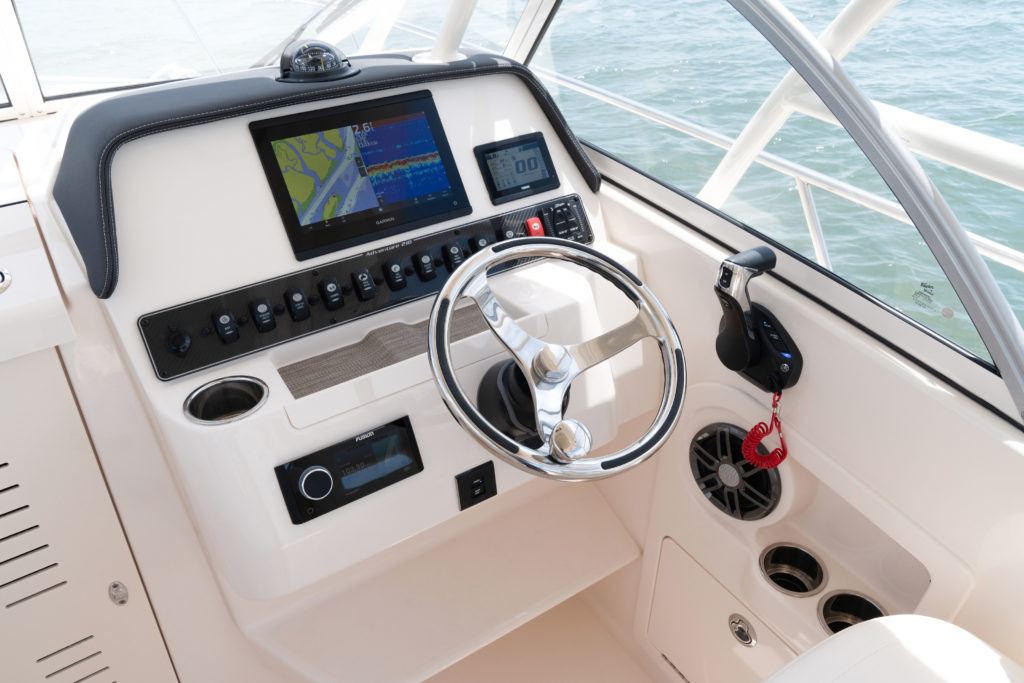
The 218 is relatively wide for its length. In addition to the cabin’s interior, the extra 6″ of beam offer comfortable space between the helm and companion seats. The hardtop—an option that we highly recommend—rides on a frame with plenty of well-shaped handholds, including several pipes of small enough diameter to be comfortable for the hands of multiple ages.
Our test boat carried the maximum horsepower, a 250-hp Yamaha 4.2-liter V-6. We ran it at a wide range of speeds on the Pamlico River around Bath, N.C., downstream of Grady-White’s headquarters in Greenville. It performed as predicted in the Performance Report on the company website, cruising happily between 24 and 34 mph (3400–4500 rpm), with a top end around 45 mph (5900 rpm).
The 218 is also available with Yamaha’s lighter but still strong 200-hp, 2.8-liter four-cylinder engine, which in the company’s test ran most efficiently at 17–28 mph (3500–4500) with a top speed of 39.4 mph at 5,900 rpm. The 200 showed a small edge in fuel economy over those speed ranges.
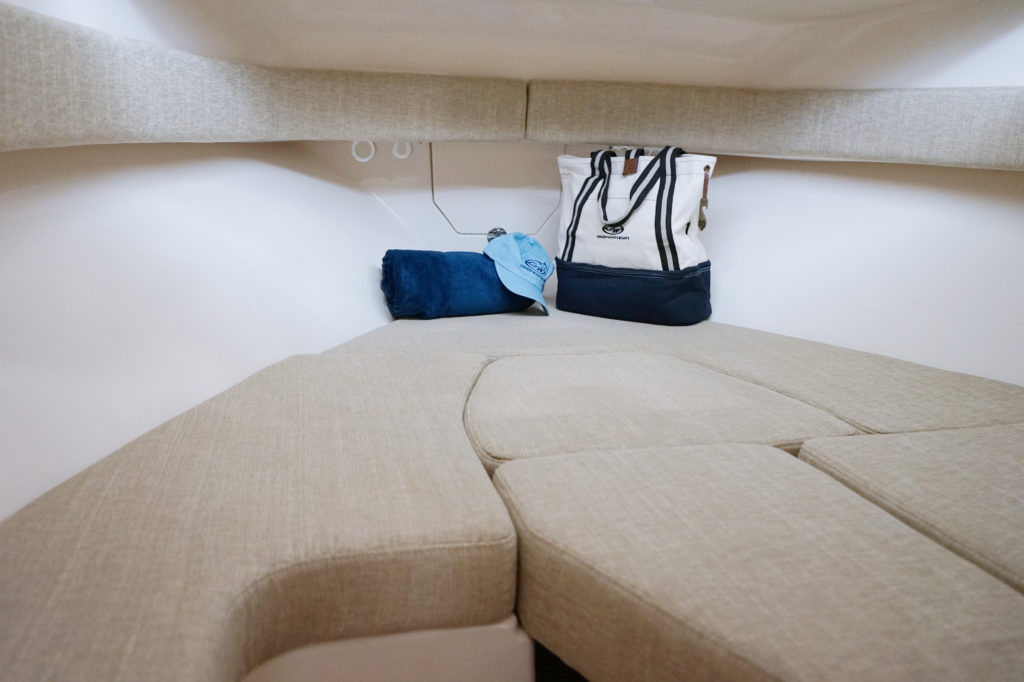
Both engines have Yamaha’s digital electronic control system, which results in exceptionally neat rigging. In our sea trial, we tinkered with the 250s running angle and the boat’s Bennett trim tabs to see how they affected speed and fuel efficiency. As expected, it will pay a new owner of this boat to run at different speeds in a variety of sea conditions in order to learn how to optimize comfort, speed and efficiency. Test day was calm, but we were able to find a couple of wakes to run through. They hardly challenged the 218’s hull. Based on our experience with other SeaV2 Gradys, it should be plenty able in more challenging conditions.
All Grady-White boats have self-bailing cockpits, carefully sized for each model with soles designed so that spray and rainwater flow aft to large, carefully finished scuppers. All deck fittings that can catch rain—including rodholders, cupholders and even popup cleats—are plumbed with drains that lead overboard. Count the number of above-water scuppers you see on the topsides of any Grady-White model to see for yourself, or take a plant tour to see how the builders construct the drains. No water goes to the bilge.
So what uses could a water-loving family or couple make of a 218 in the Chesapeake? The Adventure will adapt to virtually any Chesapeake fishery, from blue catfish and white perch up the rivers to spadefish and tautogs off the Virginia Capes, with everything from rockfish and Spanish mackerel to cobia and red drum in between. Obviously, it will make a great boat for bottom fishing with bait, casting and jigging around breaking fish, and light-tackle jigging on reefs and wrecks. Equipped with a long-shaft, bow-mount, GPS-connected electric motor (see a dealer about aftermarket rigging), it would be even more effective in those fisheries. It could also adapt to casting along marsh banks and shorelines. Want to troll? The hardtop and gunwale rodholders would allow for spreading six to 10 planer boards and deep lines.
The optional ski pylon, the twin boarding platforms and the folding ladder make the 218 a natural for watersports and swimming, with the two aft-facing fishbox seats for observers. Add cushions to the foredeck cabintop for lounging at anchor. For all-day explorations, we found that the hardtop offers shade, the cabin’s V-berth encourages naps, and its head provides comfortable, lighted, vented space with plenty of headroom for anyone in the party to use the portable toilet (a pumpout model is optional). The insulated fishboxes with overboard drains serve as coolers, or if fishing is on the agenda, add a carry-on cooler placed against the transom bulkhead between the stern seats.
While the 218 will sit happily in a wet slip (with the bottom painted) or on a lift, its size makes it relatively easy to keep on a trailer, towed behind a compact, crew-cab pickup like a Ford Ranger or Toyota Tacoma. One unorthodox but thoroughly doable use for this boat would be cruising the Bay and its rivers, stopping each night at a waterside hotel or B&B or even camping on the boat itself.
Grady-White’s new 218 Adventure is seaworthy enough to go virtually anywhere in the Chesapeake system on all but the most extreme days, but it’s compact enough to tuck in easily to small ports of call. Base boat and engine price range is $113,200 to $131,310, depending on engine (F200 or F250) and steering system (mechanical or digital electric).

